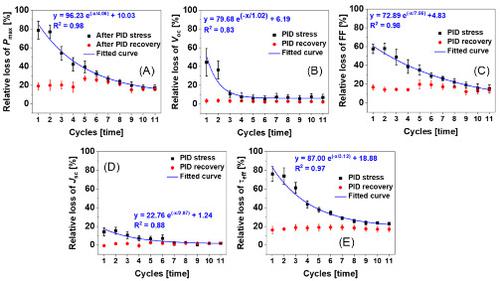当前位置:
X-MOL 学术
›
Prog. Photovoltaics
›
论文详情
Our official English website, www.x-mol.net, welcomes your feedback! (Note: you will need to create a separate account there.)
Recover possibilities of potential induced degradation caused by the micro‐cracked locations in p‐type crystalline silicon solar cells
Progress in Photovoltaics ( IF 6.7 ) Pub Date : 2020-12-04 , DOI: 10.1002/pip.3383 Dong C. Nguyen 1, 2 , Yasuaki Ishikawa 1, 3 , Yukiharu Uraoka 1
Progress in Photovoltaics ( IF 6.7 ) Pub Date : 2020-12-04 , DOI: 10.1002/pip.3383 Dong C. Nguyen 1, 2 , Yasuaki Ishikawa 1, 3 , Yukiharu Uraoka 1
Affiliation

|
Potential induced degradation (PID) has been affecting the performance, durability, and reliability of crystalline Si solar cells/modules. The authors demonstrate that micro‐cracks also act as the additional recombination centers, which reduce short‐circuit current density (Jsc), open‐circuit voltage (Voc), and the effective lifetime of carriers in solar cells, in PID condition. This hypothesis was confirmed by external quantum efficiency measurements and microwave photo‐conductance decay method at the micro‐cracked areas before and after PID stress tests. In addition, the PID recovery was made significantly but non‐fully for the laminated micro‐cracked modules owing to the electrical PID recovery method. In addition, the authors showed and discussed the challenging problems in recovering the performance of the PID‐affected micro‐cracked solar modules without lamination. The achieved results from 11 cycles of PID stress/recovery tests with the same duration of PID stress and recovery processes showed that an exponentially decreasing function fits the correlation between the relative losses of Pmax, Voc, fill factor (FF), and Jsc due to the PID stress process and the number of the PID stress/recovery cycles. This provides a model for the estimation of the relative losses of Pmax, Voc, FF, and Jsc due to the PID stress process versus the number of the PID stress/recovery cycles. Finally, based on the decreasing tendency in the performance loss of the PID‐affected laminated micro‐cracked solar modules after PID stress/recovery cycles, the authors suggest that cyclic PID tests with suitable conditions might be a reasonable approach to control PID.
中文翻译:

恢复由p型晶体硅太阳能电池中的微裂纹位置引起的潜在诱发退化的可能性
潜在的诱导降解(PID)已影响晶体硅太阳能电池/模块的性能,耐用性和可靠性。作者证明,微裂纹还可以作为附加的复合中心,从而降低短路电流密度(J sc),开路电压(V oc)。),以及在PID条件下太阳能电池中载流子的有效寿命。PID应力测试前后,微裂纹区域的外部量子效率测量和微波光电导衰减方法证实了这一假设。另外,由于电PID恢复方法,对于层压微裂纹模块,PID恢复显着但不完全。此外,作者们展示并讨论了在没有层压的情况下恢复受PID影响的微裂纹太阳能模块的性能所面临的挑战性问题。在相同的PID应力持续时间和恢复过程的11个PID应力/恢复测试周期中获得的结果表明,指数递减函数拟合P max的相对损耗之间的相关性,V oc,填充因子(FF)和J sc归因于PID应力过程和PID应力/恢复周期数。这提供了一个模型,用于估算由于PID应力过程相对于PID应力/恢复周期数而导致的P max,V oc,FF和J sc的相对损耗。最后,基于PID应力/恢复循环后受PID影响的叠层微裂纹太阳能组件性能损失的下降趋势,作者建议在适当条件下进行循环PID测试可能是控制PID的合理方法。
更新日期:2020-12-04
中文翻译:

恢复由p型晶体硅太阳能电池中的微裂纹位置引起的潜在诱发退化的可能性
潜在的诱导降解(PID)已影响晶体硅太阳能电池/模块的性能,耐用性和可靠性。作者证明,微裂纹还可以作为附加的复合中心,从而降低短路电流密度(J sc),开路电压(V oc)。),以及在PID条件下太阳能电池中载流子的有效寿命。PID应力测试前后,微裂纹区域的外部量子效率测量和微波光电导衰减方法证实了这一假设。另外,由于电PID恢复方法,对于层压微裂纹模块,PID恢复显着但不完全。此外,作者们展示并讨论了在没有层压的情况下恢复受PID影响的微裂纹太阳能模块的性能所面临的挑战性问题。在相同的PID应力持续时间和恢复过程的11个PID应力/恢复测试周期中获得的结果表明,指数递减函数拟合P max的相对损耗之间的相关性,V oc,填充因子(FF)和J sc归因于PID应力过程和PID应力/恢复周期数。这提供了一个模型,用于估算由于PID应力过程相对于PID应力/恢复周期数而导致的P max,V oc,FF和J sc的相对损耗。最后,基于PID应力/恢复循环后受PID影响的叠层微裂纹太阳能组件性能损失的下降趋势,作者建议在适当条件下进行循环PID测试可能是控制PID的合理方法。



























 京公网安备 11010802027423号
京公网安备 11010802027423号